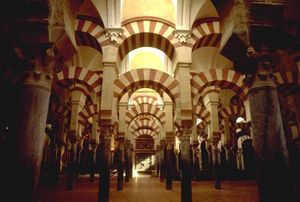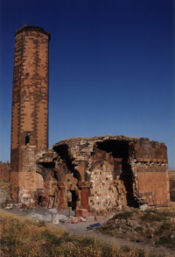 Architecture
Architecture
The general structure of mosques are a continuation of the pre-Islamic Sassanian architecture of Persia (Iran) as mentioned in the book "Persian architecture; the triumph of form and color" by Arthur Upham Pope. After the introduction of Islam to Persia, this architecture was adopted to be used for mosques by what was to later become the Muslim World.

Many forms of mosques have evolved in different regions of the Islamic world. Notable mosque types include the early Abbasid mosques, T-type mosques, and the central-dome mosques of Anatolia. The oil-wealth of the twentieth century drove a great deal of mosque construction using designs from leading non-Muslim modern architects and promoting the careers of important contemporary Muslim architects.

(click to enlarge - Interior of the Mezquita, a hypostyle mosque with columns arranged in grid pattern, in Córdoba, Spain)
Arab-plan or hypostyle mosques are the earliest type of mosques, pioneered under the Umayyad Dynasty. These mosques are a square or rectangular in plan with an enclosed courtyard and a covered prayer hall. Historically, in the warm Mediterranean and Middle Eastern climates, the courtyard served to accommodate the large number of worshippers during Friday prayers. Most early hypostyle mosques have flat roofs on top of prayer halls, which resulted in the need to use numerous columns and supports.

One of the most notable hypostyle mosques is the Mezquita in Córdoba, Spain, as the building is supported by over 850 columns.

Frequently, hypostyle mosques have outer arcades so that visitors could enjoy some shade. Arab-plan mosques were constructed mostly under the Umayyad and Abbasid dynasties; subsequently, however, the simplicity of the Arab plan limited the opportunities for further development, and as a result, these mosques gradually fell out of popularity.

(click to enlarge - The ruins of Menüçehr Camii near Kars, Turkey, believed to be the oldest Seljuk mosque in Anatolia. )

The Ottomans introduced central dome mosques in the fifteenth century and have a large dome centered over the prayer hall. In addition to having one large dome at the center, a common feature are smaller domes that exist off-center over the prayer hall or throughout the rest of the mosque, where prayer is not performed. This style was heavily influenced by the Byzantine religious architecture with its use of large central domes.

Iwan mosques are most notable for their domed chambers and iwans, which are vaulted spaces open out on one end. In iwan mosques, one or more iwans face a central courtyard that serves as the prayer hall. The style represents a borrowing from pre-Islamic Iranian architecture and has been used almost exclusively for mosques in Iran.

Many iwan mosques are converted Zoroastrian fire temples where the courtyard was used to house the sacred fire. Today, iwan mosques are no longer built. The Shah Mosque in Isfahan, Iran is a classic example of an iwan mosque.
Minarets

A common feature in mosques is the minaret, the tall, slender tower that usually is situated at one of the corners of the mosque structure. The top of the minaret is always the highest point in mosques that have one, and often the highest point in the immediate area. The tallest minaret in the world is located at the Hassan II Mosque in Casablanca, Morocco.

The first mosques had no minarets, and even nowadays the most conservative Islamic movements, like Wahhabis, avoid building minarets, seeing them as ostentatious and unnecessary. The first minaret was constructed in 665 in Basra during the reign of the Umayyad caliph Muawiyah I. Muawiyah encouraged the construction of minarets, as they were supposed to bring mosques on par with Christian churches with their bell towers. Consequently, mosque architects borrowed the shape of the bell tower for their minarets, which were used for essentially the same purpose — calling the faithful to prayer.

Before the five required daily prayers, a muezzin calls the worshipers to prayer from the minaret. In many countries where Muslims are not the majority, mosques are prohibited from loudly broadcasting the call to prayer (adhan), although it is supposed to be said loudly to the surrounding community.

The adhan is not required before every prayer. However, nearly every mosque assigns a muezzin for each prayer to say the adhan as it is a recommended practice or sunnah of the Islamic prophet Muhammad. At mosques that do not have minarets, the adhan is called instead from inside the mosque or somewhere else on the ground. The iqama, which is similar to the adhan and said immediately before the start of prayer, is usually not said from the minaret even if a mosque has one